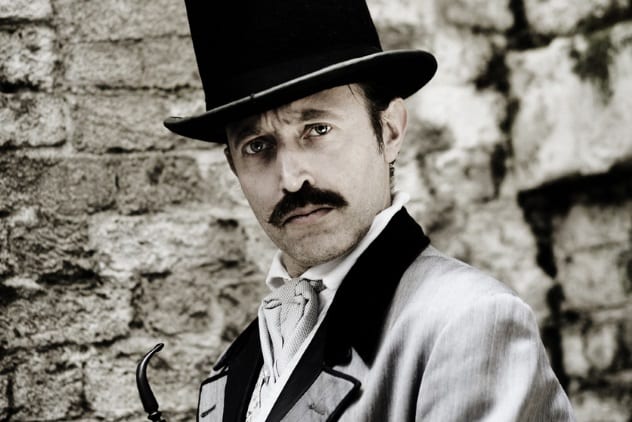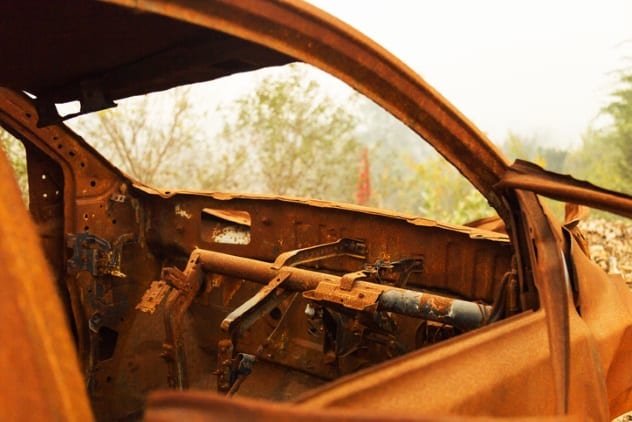 Music
Music  Music
Music  History
History 10 Less Than Jolly Events That Occurred on December 25
 Weird Stuff
Weird Stuff 10 Funny Ways That Researchers Overthink Christmas
 Politics
Politics 10 Political Scandals That Sent Crowds Into the Streets
 Weird Stuff
Weird Stuff Ten Bizarre Facts About The Doge Meme
 Our World
Our World 10 Ways Your Christmas Tree Is More Lit Than You Think
 Movies and TV
Movies and TV The 10 Coolest Stars to Set Sail on The Love Boat
 History
History 10 Things You Didn’t Know About the American National Anthem
 Technology
Technology Top 10 Everyday Tech Buzzwords That Hide a Darker Past
 Humans
Humans 10 Everyday Human Behaviors That Are Actually Survival Instincts
 Music
Music 10 Surprising Origin Stories of Your Favorite Holiday Songs
 History
History 10 Less Than Jolly Events That Occurred on December 25
 Weird Stuff
Weird Stuff 10 Funny Ways That Researchers Overthink Christmas
Who's Behind Listverse?

Jamie Frater
Head Editor
Jamie founded Listverse due to an insatiable desire to share fascinating, obscure, and bizarre facts. He has been a guest speaker on numerous national radio and television stations and is a five time published author.
More About Us Politics
Politics 10 Political Scandals That Sent Crowds Into the Streets
 Weird Stuff
Weird Stuff Ten Bizarre Facts About The Doge Meme
 Our World
Our World 10 Ways Your Christmas Tree Is More Lit Than You Think
 Movies and TV
Movies and TV The 10 Coolest Stars to Set Sail on The Love Boat
 History
History 10 Things You Didn’t Know About the American National Anthem
 Technology
Technology Top 10 Everyday Tech Buzzwords That Hide a Darker Past
 Humans
Humans 10 Everyday Human Behaviors That Are Actually Survival Instincts
10 Bizarre Burnings Weirder Than Spontaneous Combustion
The phenomena called “spontaneous human combustion” (or SHC) is supposedly when a living body somehow ignites itself from the inside, resulting in death. Subatomic particles, ball lightning, and poltergeists have been blamed for SHC. Less sensational explanations include the wick effect or simply an overlooked external source of ignition.
Whatever the cause(s) of spontaneous human combustion, the cases lined up here prove it to be a hodgepodge of any weird thing that involved fire. How weird? Let’s look at some of the strangest reports ever recorded!
10 In And Out

Fire, apparently, can make its way out of a human body in a variety of ways, but vomiting and excreting fire have got to be the worse! A number of reports from the 1600s detailed people burping up flames after drinking brandy, known in Latin as “burning wine.” A Polish knight in the time of Queen Sforza drank two glasses of brandy, which doesn’t seem like much. But then, flames erupted from his mouth violently enough that he died from the results. In the mid-1600s, it was reported that three English noblemen were “drinking strong liquors” when flames erupted from the mouths of two of them, suffocating the poor men.[1]
Still, as scary as vomiting flames may sound, there may be a far worse way to expel fire from your body. It’s said that Joannes Eusebius Nierembergensis, an author in the early 1600s, not only reported several incidents of people barfing flames after drinking wine and brandy but that he also recorded one unfortunate incident in which “Fire came out from the privy Parts of a Woman.” Let that sink in.
9 Backache

Sometime before 1642 (when an account of this was published), a guy named Alexandrini Medici Megetij had one of the oddest medical problems ever reported. The book it was reported in was called Ignis Lambens by Ezekiel de Castro, and he was mostly writing about incidents describing people with glowing skin, which appears to have been a going thing at the time, when he stopped to make note of one incident in particular that was just weird.
Apparently, under unknown circumstances, Megetij had a flame project itself from the base of his spine. This was witnessed by two other men who, presumably, were in the right place at the right time.[2] We are not told more about the incident—whether Megetij was permanently hurt or killed by the experience, what the two men thought of the matter, where they were, or what they were doing—nothing. Yet around a century later, when author Paul Rolli wrote up the first essay that proposed the idea that human bodies could self-ignite, Rolli felt for sure that Megetij was an early example of his newly proposed idea.
8 Carpenters Burn Really Well

On Saturday, June 26, 1613, a carpenter named John Hitchell who lived in Christchurch in England had gone straight to bed after a hard day’s work, soon joined by his wife and child. Later that night, his mother-in-law (sleeping in a different bed in the same room) was awakened by what she assumed to be a sudden crack of lightning that had struck her on the cheek. She cried for help but got no response, so she walked over to the other bed to wake her daughter . . . and was in for a shock.
John and his child were both dead and apparently burning with a slow flame. Hitchell’s wife was horribly burned on the side facing the corpses of her husband and child, but she was still alive. Having been stirred from her very deep sleep by her mother, Hitchell’s wife (along with her mother) then dragged the still-burning John out of the house to the street, where he was abandoned by them when the heat coming from his body became too intense. Hitchell’s corpse lay in the street, still burning, for the next three days until it was fully reduced to just ashes and a few bits of bone.[3] Anyone care to guess how all of that happened?
7 The Soldier Retires

In Aberdeen, Scotland, in the year 1888, 65-year-old retired soldier Alexander Morrison was in a fine intoxicated state. He could still walk and talk and was most definitely in a good mood when he was last seen alive by a young couple he asked to shut the door of the stable he was sleeping in after him, which they did. The following morning, smoke was seen coming from a hole in the roof of the stable, and when this was investigated, a most horrifying, yet beautiful, thing was found. Alexander Morrison’s body had been almost entirely converted into just ash and bone yet still showed every detail of his body and features as if sculpted by a master artist.
In whatever manner Morrison had caught fire, he had only managed to burn the floor under him and the ceiling directly above, which had created the hole through which the smoke was leaving. The hay in the hayloft was unburned, and although the joist and a bit of floor under his body was still there, a ring of flooring around his body had burned completely away. Luckily, he had been leaning against a stone wall, so the walls hadn’t caught fire.
Morrison’s face and mustache were still visible and recognizable by people who knew him in the cinder his head had become, and except for where wood from the ceiling had landed on him, details such as the wrinkles in his clothing were still visible in the ashy remains. Not everything was perfect; his hair was gone, the top of his skull could be seen, and his back had been burned and exposed down to his ribs. It seemed that this damage had been caused by the falling slates, so the figure would have been even more perfect had it been found earlier.[4]
A picture was taken, from which a lithograph was made and later printed in the British Medical Journal, which was a good thing because when an attempt was made to move the remains, the “body” just plain fell apart.
6 The Shop Owner’s Death

Some accounts of fire death appear to point to a truly scary occurrence. Take, for example, the death of Andrew Nolte in 1867, a case that caught the attention of the famous novelist Charles Dickens.
Nolte was the owner of a liquor store in Columbus, Indiana, US, and was known to be a drunkard . . . so much so that his wife had filed for divorce because of it, which only made him drink more. On the morning of February 15, drinking ceased to be a problem for him. Around 8:00 AM, people investigating smoke coming from Nolte’s shop found him lying dead on his back, his hands drawn up to his mouth as if to grab something. The front of his clothes were burning, and there were some scorches on his body under the clothing, but that’s not what killed him.
Nolte’s mouth had been incinerated horribly, his lips burned away and his tongue charred; his nostrils were burned also, as if Nolte had been blowing flames from them. There was no other evidence of fire in the room—just Nolte’s incinerated airway.[5]
5 An Evil Spark

The year was 1776, and it had been a busy day in the town of Filetto, Italy, for priest Don G. Maria Bertholi, and he was quite ready for bed when he arrived at his brother-in-law’s house that evening. He retired to his given room, put a handkerchief between his shoulders and shirt, and settled into his prayers as everyone else in the house settled down to sleep.
Then there was a loud noise from Bertholi’s room, followed by cries of pain and alarm from the priest. The members of the household ran to the room to discover Bertholi lying on the floor, surrounded by a strange, flickering blue flame that receded away as it was approached, until it just disappeared. Bertholi’s nightshirt and cap had been destroyed, leaving just the cuffs of the shirt; his hair was untouched by whatever had destroyed the cap. The family helped the priest to the bed and called a doctor as early as possible in the morning. What this doctor saw astounded him.
The skin on Bertholi’s right arm and side was hanging loose, mostly detached from the muscle underneath, and the priest’s right hand was already showing obvious signs of decomposition less than a day from the strange occurrence. The doctor removed the loose skin and amputated Bertholi’s hand, but by the next day, all the wounded areas were showing advanced signs of decomposition, and Bertholi was intensely feverish, vomiting, and delusional. By the fourth day, Bertholi had died, smelling of rot and with maggots pouring from his wounds.
The doctor tried to find out what had happened to Bertholi, but all the priest could offer was that he felt as if he’d been struck on the right arm at the same time that he saw a spark of fire attach itself to his shirt. All the doctor could guess was that, somehow, Bertholi had been struck by lightning while inside a house and praying, but how that leads to accelerated rotting is anyone’s guess.[6]
4 Raise Your Hands

It was a hot day in 1822, and 40-year-old Renateau was walking to his home in the village of Loignan, France, accompanied by a girl who was not his wife when it happened. Just a few hundred feet from his house, he felt a sharp pain in the index finger on his right hand. He looked at it, and it was on fire. Automatically, he pinched the index finger between his thumb and middle finger to stifle the flame, but then those digits lit up. Not surprisingly, Renateau started to panic around this time, and in his frenzied attempts to suffocate the flames, he managed only to burn two holes in his pants, set his pouch on fire, and, while trying to remove the pouch, set his left hand aflame.
At this, Renateau ran the remaining distance to his house and ordered his wife to get a bucket of water, into which he plunged both hands. When he pulled them out, they were still burning. Next, he submerged his hands in mud to try to stifle the infernal flames, but his hands continued to burn. By this time, Renateau had attracted a certain amount of attention, and one devout young lady suggested he should try holy water. She brought him a bowl of it . . . and, sure enough, the holy water finally doused the persistent flames on his hands.[7]
This all only begs the question: Why was he walking home with a girl who was not his wife, and exactly what was he doing with his hands before they caught fire?
3 A Carefully Handled Combustion

On January 5, 1835, a professor at the University of Nashville apparently had a very close encounter with some form of spontaneous human combustion. James Hamilton, professor of mathematics, was on a lunch break and walked home from the university to busy himself with some atmospheric measurements. He built a fire and then spent half an hour observing a barometer and thermometer on the other side of the room. After this, he headed outside, where he spent ten minutes in a chill wind observing a hygrometer. Then he felt a sudden pain in his left thigh.
At first, the pain felt as sharp as hair being pulled, but upon touching the spot, it quickly became more intense until he found himself crying out over it. Then it got stranger: A light flame, about the circumference of a dime, became visible on his clothing above the pain. Did he panic? No! Hamilton cupped both his hands over the flame tightly, not touching it but cutting off its supply of air as best he could, soon suffocating the flame and relieving the greater part of the pain. He pulled down his pants to look at the spot and found what looked like an 8-centimeter-long (3 in), 2.5-centimeter-wide (1 in) scrape that was extremely dry. His underwear was burned through exactly where it had been lying over the wound![8]
2 Motor Mystery

On November 20, 1960, a little girl playing by a creek near Pikeville, Kentucky, made a grisly discovery. Five men burned beyond recognition sat in a car. The car had gone off the road and stopped with the front in the creek. There had been no impact; the car had just rolled to a stop. There was no gas in the tank. Though the outside of the car looked undamaged, the interior of the vehicle was incinerated, and police initially suspected foul play for simple reasons: The men were all upright in their seats and showed no signs of having struggled to escape the fire. In addition, metal detectors suggested possible pellets or bullets in the chest areas of the men, and there was blood on the ground near the car.
But the autopsies showed that the metal had dripped from the ceiling of the vehicle as it started to melt and that the men had high levels of carbon monoxide in their bodies, meaning they were alive and breathing when the fire started. It was determined that it was the carbon monoxide that, ultimately, killed the men. For lack of a better theory, police decided that the fire had started at the front of the vehicle and moved back, but it was never stated how this odd fire started. Nor was it explained why five men in a burning vehicle would calmly drive a car off a road, nor where the blood on the ground came from, nor why the five men, alive and breathing, would calmly sit still as they burned to death.[9]
1 Spontaneous Animal Combustion?

It has been argued that if human bodies can just catch fire on their own, then animals should be lighting up, too . . . but there are only two known reports of possible spontaneous animal combustion, and they’re just plain weird. The first was reported in 1745 by Paul Rolli, the first person to propose the idea of human bodies self-igniting. According to Rolli, sometime around 163 BC, when Tiberius Sempronius Gracchus II and M. Juventius Thalna were both consuls in Rome, it was reported that “a flame came out of a bull’s mouth, without hurting the beast, by not finding any resistance to its way.” It’s a interesting report, but Rolli doesn’t say where he found it, so it’s hard to give it much credit.
The second known report is far more recent. According to Jenny Randles and Peter Hough, a soldier named Raymond Reed was with the 9th Battalion of the Royal Welch Fusiliers during World War II and was stationed in Dorset, England. One night, Reed, another soldier, and an officer were patrolling along the coastline in the dark and were crossing an open field full of grazing sheep when a fire suddenly erupted about 91 meters (300 ft) away from them. They investigated, being careful as they approached, and found a burning sheep lying on its side, with blue flames pouring from its stomach! The sheep was not decomposing and, in fact, was “quite fresh looking.” Somewhat confused, Reed and the other men extinguished the flames with dirt. Then Reed waited 50 years before telling anyone what he had seen. Can you blame him?[10]
Garth Haslam has been digging into strange topics for over 30 years and posts his research on varying anomalies, curiosities, mysteries, and legends at his website, Anomalies—the Strange & Unexplained. Check it out at http://anomalyinfo.com.
Read about more anomalous fires on 10 Intriguing Cases Of Apparent Spontaneous Human Combustion and 10 Mysterious Fires Caused By Ghosts.








